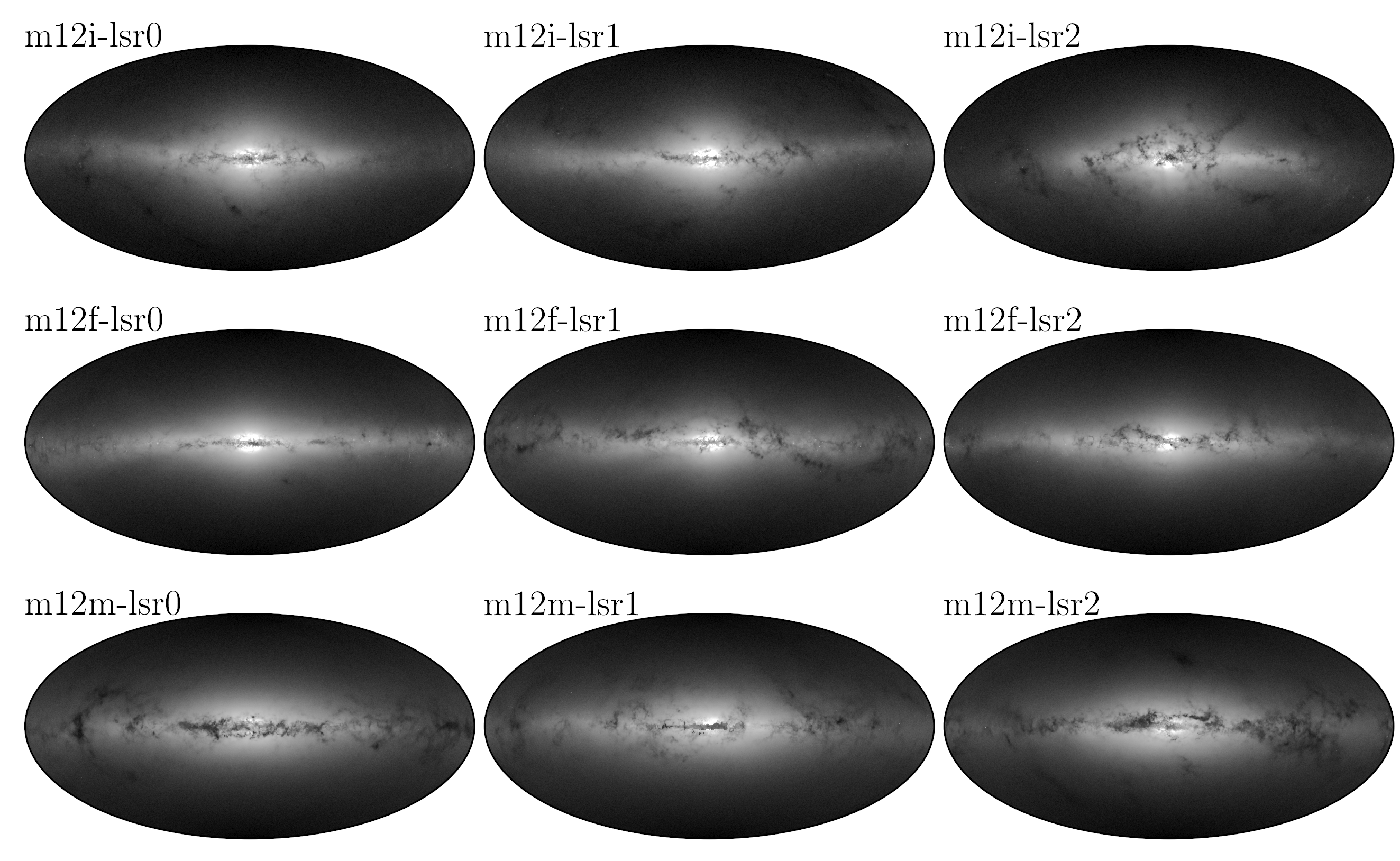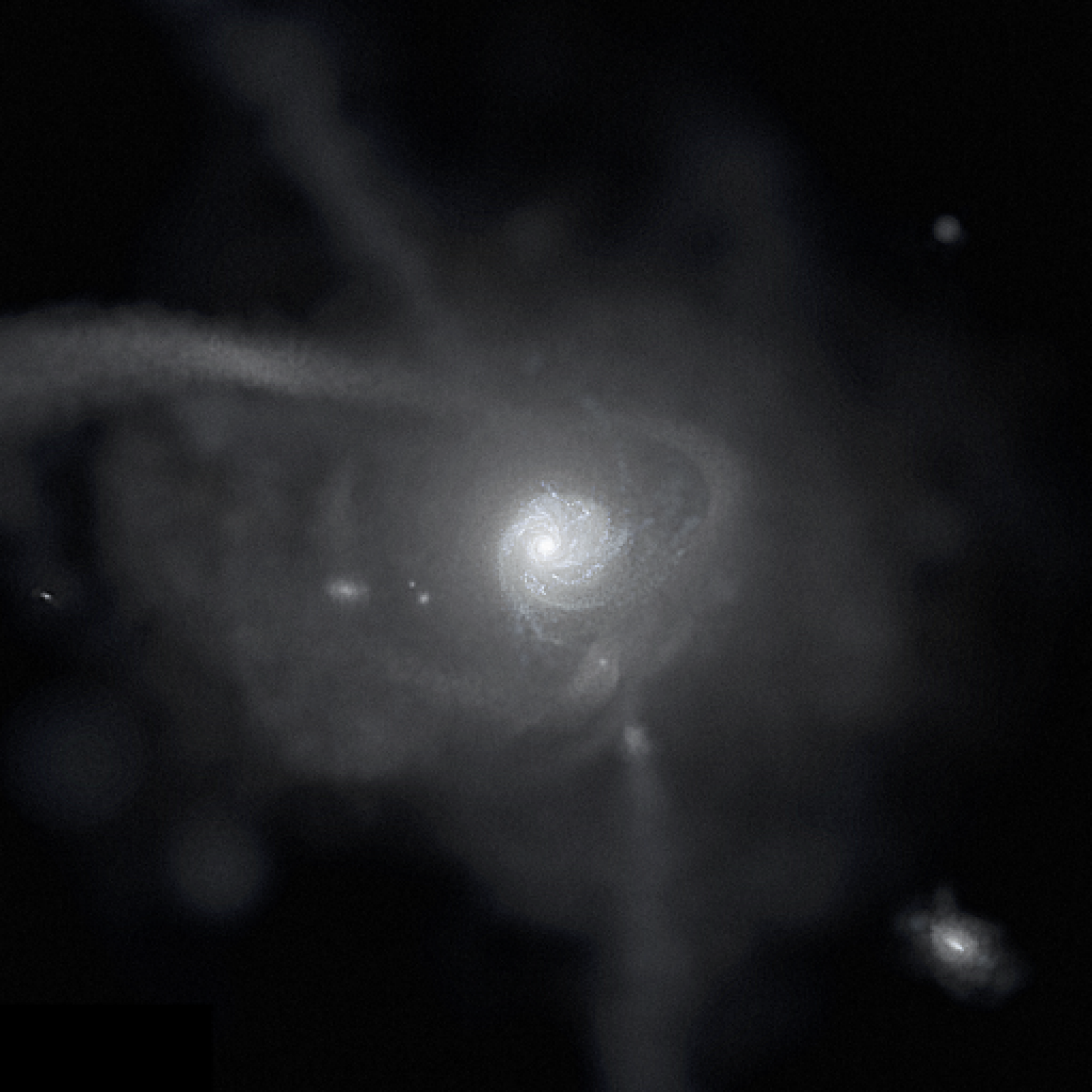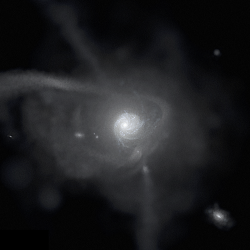flying through a Latte cosmological simulation of a Milky Way-like galaxy (m12f), showing its evolution over the last 1 billion years (movie credit: Phil Hopkins)
flying through another Latte simulation (m12i)
Formation histories, over 13.8 billion years, of 3 galaxies in the Latte suite of FIRE-2 cosmological simulation of Milky Way-like galaxies (m12i, m12f, m12m), showing stars (first version) and gas (second version) out to 400 kpc, including satellite galaxies. (movie credit: Shea Garrison-Kimmel)

Latte: overview
I am leading the Latte suite of FIRE simulations of Milky Way-mass galaxies (Wetzel et al 2016), part of the FIRE simulation project.
Our Milky Way provides the best laboratory to study the physics of galaxy formation and to test the nature of dark matter. Excitingly, a new generation of observations is revolutionizing our view of the Milky Way: the Gaia mission, Hubble Space Telescope (HST) and James Webb Space Telescope (JWST) , Dark Energy Survey (DES), Large Synoptic Survey Telescope (LSST), and a multitude of ground-based spectroscopic surveys (such as RAVE, SDSS-APOGEE and SDSS-5, GALAH, Gaia-ESO, LAMOST, PRISTINE, Subaru PFS, 4MOST, WEAVE) are measuring full orbital phase-space distributions (3D position + 3D velocity) and multi-species elemental abundances for 100’s of millions of stars in the Milky Way and its satellite galaxies. A critical challenge in interpreting these unprecedented datasets is the lack of sufficiently realistic (cosmological) theoretical modeling tools.
A primary goal of the Latte simulations is to understand the formation of our own Milky Way galaxy in a cosmological context, by self-consistently modeling the dark-matter + gaseous halo, stellar + gaseous disk, bulge, giant molecular clouds (GMCs), star clusters, stellar halo, and satellites galaxies of Milky Way-like systems across their full 13.8 billion-year formation. We seek to use these simulations to address key problems in:
galactic history – reconstructing the Milky Way’s entire formation history in full 6-D orbital phase space, including also enrichment in elements
near-field cosmology – using stellar and gas dynamics to measure the distribution, and test the particle nature, of dark matter around us
To accomplish this, the Latte simulations push the resolution frontier, simulating Milky Way-like galaxies at ultra-high resolution, with particle masses of 7070 solar masses and spatial resolution down to 1 pc. Thus, Latte achieves high dynamic range to resolve phase structure in the interstellar medium, allowing gas to collapse into resolved giant molecular clouds and allowing stars to form within them in clusters. This resolution also allows us to model star particles self-consistently as single-age mono-abundance stellar populations, facilitating comparisons to stellar populations across the Milky Way. Furthermore, our new Ananke framework (Sanderson et al 2020) allows us to generate synthetic stellar surveys of the Latte simulations to compare directly against the Milky Way.
This combination of (1) ultra-high resolution, (2) FIRE physics model, and (3) Ananke synthetic surveys, together make the Latte simulation suite an unprecedented theoretical tool for understanding the formation of the Milky Way (as well as Andromeda and similar-mass galaxies) in a cosmological context.

Latte: in detail
In more detail, the Latte simulations are a suite of individual (isolated) Milky Way-mass halos that we simulated using the same resolution, cosmology, and FIRE-2 physics model. We selected them from cosmological volumes of periodic box lengths spanning 85.5 to 172 Mpc, using flat ΛCDM cosmology. From these volumes, we select halos at z = 0 based only on their mass (M_200m = 1 – 2 x 10^12 Msun) and an isolation criterion (no neighboring halos of similar mass within at least 5 x R_200m) to limit computational cost. In particular, our selection is agnostic to any halo properties beyond mass and isolation, including formation history, concentration, spin, or subhalo population.
Each Latte simulation represents a cosmological zoom-in region around a single Milky Way-mass halo. This zoom-in region is simulated at full resolution with dark matter, gas, and stars, embedded within the full cosmological volume, which is simulated self-consistently but at low resolution and with only dark matter. The zoom-in region around each MW-mass halo is typically a few Mpc in size, and all of the Latte simulations have zoom-in regions that are uncontaminated by low-resolution dark matter out to at least 600 kpc at z = 0.
The Latte simulation suite has particle mass resolution:
- 35,000 Msun for dark-matter
- 7070 Msun for gas
- 7070 Msun initially for stars (~5000 Msun typically because of stellar mass loss)
and spatial (force) resolution:
- 40 pc for dark matter
- 4 pc for stars
- 1 pc (minimum) for gas
Wetzel et al 2016 introduced the Latte simulations and showed that they produce a realistic population of satellite galaxies. Since then, these simulations have been used in over 50 published articles.
We have shown that the Latte simulations produce galaxies that agree with many observed properties of the Milky Way, Andromeda, and similar-mass galaxies at z = 0, including their satellite populations, without any ‘fine-tuning’ of our FIRE-2 physics model, including:
Comparison with the Milky Way and nearby galaxies
stars
- stellar-to-halo mass relation (Hopkins et al 2018)
- stellar disk morphology, kinematics, and metallicity gradient (Ma et al 2017, Sanderson et al 2020, Garrion-Kimmel et al 2019, Santistevan et al 2021)
- correlation of star formation with stellar mass density (Hani et al 2020)
- stellar bulge formation and kinematics (Debattista et al 2019)
gas
- inter-stellar medium kinematics at z = 0 (El-Badry et al 2018a, El-Badry et al 2018b), evolution over time (Hung et al 2019), relation to star formation (Orr et al 2020), metallicity gradients/variations (Bellardini et al 2021)
- molecular gas emission (Keating 2020), giant molecular clouds (Guszejnov et al 2020, Benincasa et al 2020), central molecular zone (Orr et al 2021)
- circum-galactic medium origin and fate (Hafen et al 2019, Hafen et al 2020)
Comparison with stellar halos
- properties of stellar halos as compared with the Milky Way and nearby galaxies (Bonaca et al 2017, Sanderson et al 2018)
Comparison with satellite galaxies
- Latte simulations do not suffer from the ‘missing satellites’ or ‘too-big-to-fail’ problems in ΛCDM cosmology (Wetzel et al 2016, Garrison-Kimmel et al 2019)
- radial distance distribution (Samuel et al 2020) and planarity (Samuel et al 2021)
- distribution of elemental abundances (Escala et al 2018)
- star-formation histories (Garrison-Kimmel et al 2019)
We also have used the Latte simulations to make predictions for:
predictions for the Milky Way and nearby galaxies
stars
- cosmological formation histories (Santistevan et al 2020)
- origin and location of ancient metal-poor stars (El-Badry et al 2018, Santistevan et al 2021), dynamical effects of potential fluctuations (Beane et al 2019) and bursty star-formation histories (Yu et al 2021)
- elemental abundances and chemical tagging (Bellardini et al 2021)
- star formation timescales of observable tracers (Flores Velazquez et al 2021)
gas
- origin of pressure balance (Gurvich et al 2020)
- galactic winds (Pandya et al 2021)
- giant molecular clouds: cosmological evolution and lifetimes (Guszejnov et al 2020, Benincasa et al 2020)
- circum-galactic medium origin and stability of hot gas (Stern et al 2020, Esmerian et al 2020)
black holes
- supermassive black hole accretion and growth rate (Angles-Alcazar et al 2017)
- binary black holes and white dwarfs (Lamberts et al 2018, Lamberts et al 2019, Sesana et al 2020, Rodriguez et al 2020)
predictions for stellar halos
- modeling dark-matter halo masses (Sanderson et al 2017)
- spatial and velocity anisotropies (Cunningham et al 2019)
- stellar-halo stars formed in outflows (Yu et al 2020)
- discovering accreted stars and galaxies (Ostdiek et al 2020, Necib et al 2020)
predictions for the dark-matter halo
- dark-matter subhalo populations (Garrison-Kimmel et al 2017, Nadler et al 2018, Barry et al in prep)
- velocity distribution of dark matter near the Sun (Necib et al 2019)
- cored density profiles of dark matter (Lazar et al 2020)
- density profiles in self-interacting and dissipative dark-matter models (Sameie et al 2021, Shen et al 2021)
Read more about Latte and the broader suite of FIRE-2 simulations at the FIRE project website.

Publicly available data
In Wetzel et al 2023, we describe the public data release (DR1) of the FIRE-2 simulations, available at flathub.flatironinstitute.org/fire. DR1 includes full snapshots (including all dark matter, gas, and star particle data) from all of our Latte Milky Way-mass simulations (and all of our ELVIS Local Group-like simulations, see below) across z = 0 to 10, including halo/galaxy catalogs, catalogs of stellar streams, formation coordinates and an ‘ex-situ’ flags for all star particles at z = 0.
DR1 extends our initial data release (DR0) of 3 of the Latte simulations (m12f, m12i, m12m) at z = 0, which includes synthetic Gaia DR2-like surveys (Sanderson et al 2020, see below) created from these simulations, available via yt Hub at ananke.hub.yt.
Binary Black Hole catalog
Our public release of Latte also includes data from our model for the binary black hole population in/around the Milky Way (Lamberts et al 2018), as modeled using one of the Latte simulations (m12i). This represents the first combination of a high-resolution cosmological simulation of a Milky Way-mass galaxy with a binary population synthesis model in this context. Our model predicts ~1 million binary black holes in/around the Milky Way at z = 0, with a mean mass of 28 Msun. Access our binary black hole catalog via yt Hub at ananke.hub.yt.

Ananke: synthetic gaia surveys of Latte simulations
We developed the Ananke framework (Sanderson et al 2020) to generate realistic synthetic stellar surveys from cosmological baryonic simulations. We used Ananke on the Latte simulations to create a set of synthetic stellar surveys that resemble the Gaia satellite mission‘s Data Release 2. We generated 3 synthetic surveys (each using different solar positions) from each of 3 Latte simulations, for a total of 9 synthetic surveys.
Each synthetic Gaia DR2-like survey features:
- Cosmological formation histories with self-consistent dark-matter and gas accretion, satellite galaxies, and tidal streams/shells.
- Spatially resolved stellar populations and young star clusters in realistically thin and dynamically complex star-forming disks. The Latte simulations provide sufficient resolution to model kinematically cold, single-age, mono-abundance stellar populations at mass resolution ~5000 Msun at z = 0, comparable to (massive) star clusters. Furthermore, the gas spatial resolution (as small as 1 pc) and temperature range (as cold as 10 K) resolve the formation of giant molecular clouds (GMCs) and the clustered formation of young stars inside of them.
- Complete stellar populations synthesized using a Kroupa stellar initial mass function (IMF) and PARSEC model stellar isochrones.
- Self-consistent dust extinction calculated using a constant dust-to-metals ratio, documented for easy adaptation to other extinction models. This provides realistic correlations between (young) stars and gas, including dust extinction near star-forming regions.
- Simulated Gaia DR2-like uncertainties based on survey averages, with intrinsic values provided for use with more sophisticated error models.
The result is a self-consistent, dust-extincted synthetic survey of each simulated galaxy that leaves intact important observational relationships between gas, dust extinction, stellar populations, and dark matter. Read more about these synthetic Gaia DR2-like surveys and access them via yt Hub at ananke.hub.yt.
Spin around an ELVIS on FIRE cosmological simulation of a Local Group-like system (Romeo & Juliet), showing stars. (movie credit: Shea Garrison-Kimmel)
Formation history of Romeo & Juliet, showing stars (top) and gas (bottom)
elvis: the Local Group on FIRE
In addition to the Latte suite of individual Milky Way-mass galaxies, our full FIRE-2 simulations suite also includes simulations of Local Group-like volumes, which include a pair of Milky Way + Andromeda-mass galaxies at their measured masses, relative distances and velocities. These Local Group-like volumes extend out to several Mpc to model the low-mass galaxy population on the Local Volume. Shea Garrison-Kimmel led this “ELVIS on FIRE” simulation suite (which is an extension of his previous ELVIS suite of dark-matter-only simulations). ELVIS on FIRE has even better resolution than the Latte suite: baryonic particles of just 3500 – 4000 solar masses. See Garrison-Kimmel et al 2019 for more details about ELVIS on FIRE.

